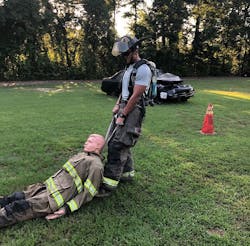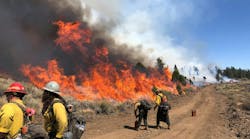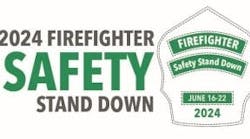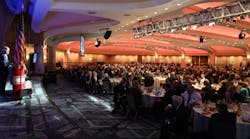In the fire service, we preach about the importance of training, and how it can greatly improve our effectiveness during an emergency incident. We also emphasize the need to be physically fit to perform the duties and tasks that may be required of us when the tones drop. The question is, although we demand both, are they both being accomplished? Training on forcible entry and ladder placement is great, but if our firefighters cannot physically carry a ladder or force a door, then our abilities are only book-knowledge deep. The same can be said if our members have biceps of steel, can lift ungodly amounts of weight, and run for miles without getting tired, but are unable to accurately read flow paths or perform a simple search pattern.
We need to combine both very important activities to accomplish the ultimate goal of providing the best level of service to the communities that we serve. The strongest, most powerful tool in our arsenal is our brain. We must prepare not only physically, but also mentally for the challenges we face.
I've seen crews boast that they "train together to survive together." This sounds great until you consider what level of training is actually being performed. Does the training consist of situations that could potentially save your or your brother/sister's life if you or they became trapped or injured? What about modern building construction and how it affects fire behavior or how it could affect the potential need to get out in a hurry?
There are several firefighter survival classes that teach firefighters how to keep calm in stressful situations and utilize their equipment, experiences and, most importantly, training, to go home safely at the end of the day. These classes focus on topics like air conservation, calling a mayday, firefighter egress, etc. We hope this knowledge doesn’t need to be put to use in an actual incident, but having that knowledge makes you and your crew better equipped on every call.
The difference between training and working out
We need to step back and look at what we are calling "training”—to take an honest look and see if what we are doing is genuine training. Are we training on drags and carries or are we simply dragging a dummy with a drag rescue device (DRD) around to help improve endurance? We may tell ourselves that we are training, but are we preparing ourselves for a potential rescue? What if the victim doesn't have a DRD, is overweight or has limited amounts of clothing?
Hitting a tire with a sledge is a great way to train on vertical ventilation, but does a rubber tire present us with the same problems that a roof would? If we train on nothing but a tire, would we be able to know when we are on and off a stud? Or if we are used to the recoil of a rubber tire, would we be able to recognize a spongy roof before it was too late?
The same can be said for the reverse scenario. We can know everything about different drag and carry techniques to fit various situations. We can be an expert on all the steps and procedures to rescue a victim from a bed, kitchen floor or the bathroom, but if we aren't physically able to perform the rescue, then we are just as useless. If we as a department can have the knowledge of where, when and how to perform a vertical ventilation cut, but don't have the physical strength to do the actual cutting, then we are still ineffective.
We need to recognize the importance of both training and working out, but not confuse one with the other. Training can both strengthen the mind and body as can working out, but in two completely different ways. Physical training will push the body, while allowing members to experience real-world scenarios. Facing obstacles that could potentially present themselves during an actual incident will allow a firefighter to learn from that experience while still breaking a sweat.
We as a fire service cannot put ourselves above those who depend on us in their times of need. We can no longer afford to lie to both the community and ourselves by saying we train every day, when that training only consists of pulling a sled across the bay floor or maxing out our new squat limit. Regardless of what we may call it, if our training only consists of activities meant to better our appearance and personal stats, then we are ultimately doing nothing more than just chasing our selfish goals.
Knowledge AND fitness are needed
The calls that we face today are not the calls that our brothers and sisters faced before us. With the constant changes in building construction, vehicle design, pre-hospital care and the growing threat of potential firearm-related incidents, we cannot rest upon the complacent "I already know this stuff" mentality.
With all these changes, the need for physical training is ever more precedent. Training that utilizes both common situations to ensure our basic foundation of knowledge is firm, but also preparing for those high-risk/low-frequency calls that we don't see on a regular basis.
Inarguably, this job is extremely physically demanding. It requires that we not only have strength, but also stamina and endurance. Being in top physical shape not only helps us perform our duties more proficiently, but also can lead to better long-term health.
Having a healthy combination of both can ensure that we will always be ready for whatever may lay in store when we arrive on scene. Having gained knowledge through practical training as well as better fitness through traditional exercise will help us provide the level of service the general public has grown to expect.
It's often been said that a chain is only as strong as its weakest link. It can also be said that a crew is only as strong as its weakest member. It's time we not only focus on physical strength, but we also strive to be knowledgeable, intelligently aggressive firefighters with sound tactics.
The days of a fire service that only requires “strong backs and weak minds” are over. Why does it have to be one or the other? Why can't we have strong backs and strong minds? We can utilize battling rope as well as ropes and knots, or the tire and sledge and vertical ventilation techniques. Blending the workout with scenarios we could actually see is paramount.
We need to train as if our lives depend on it because it does. But that's not all. Our fellow firefighters and the citizens whom we serve also depend on us. Change needs to start with us, and it needs to start now.






